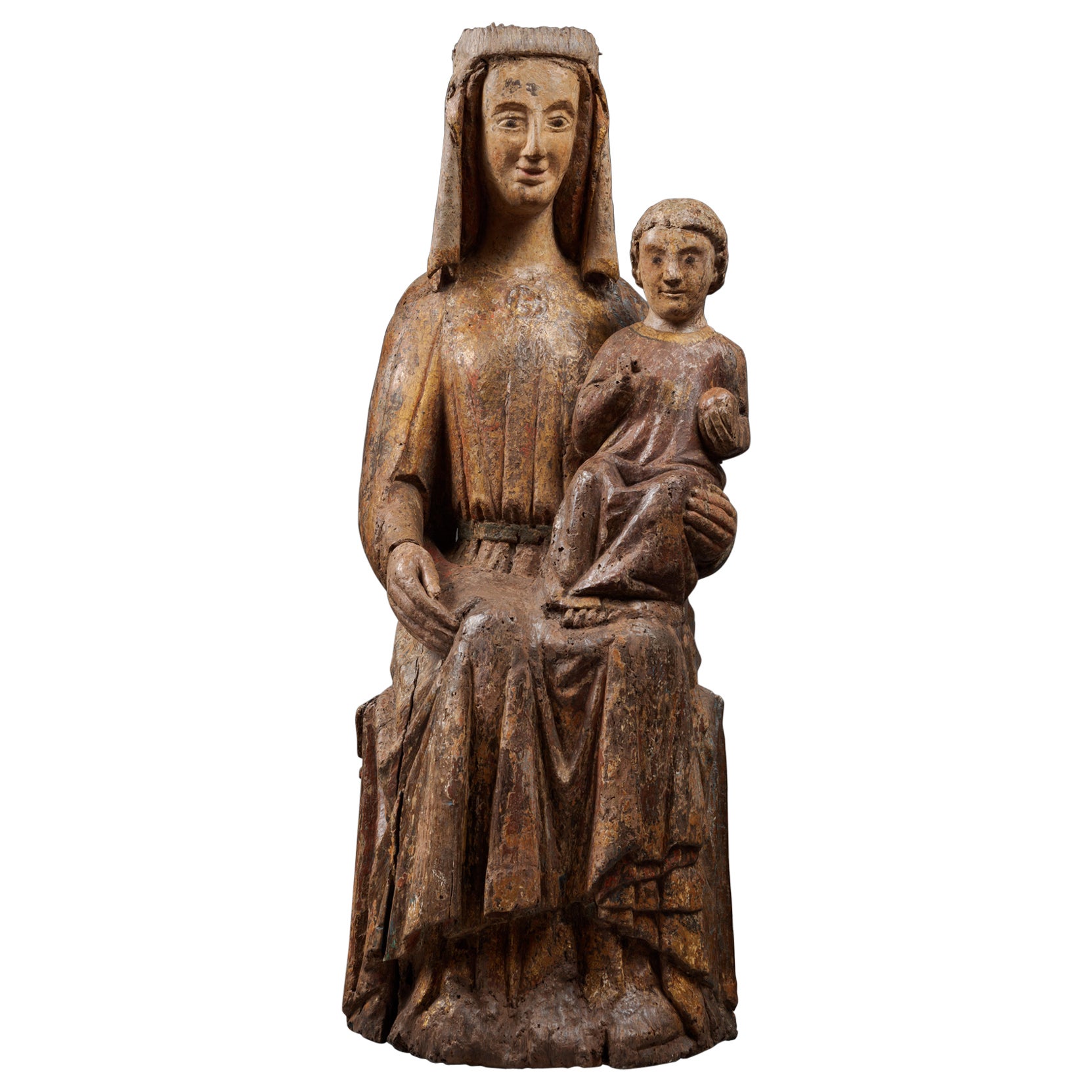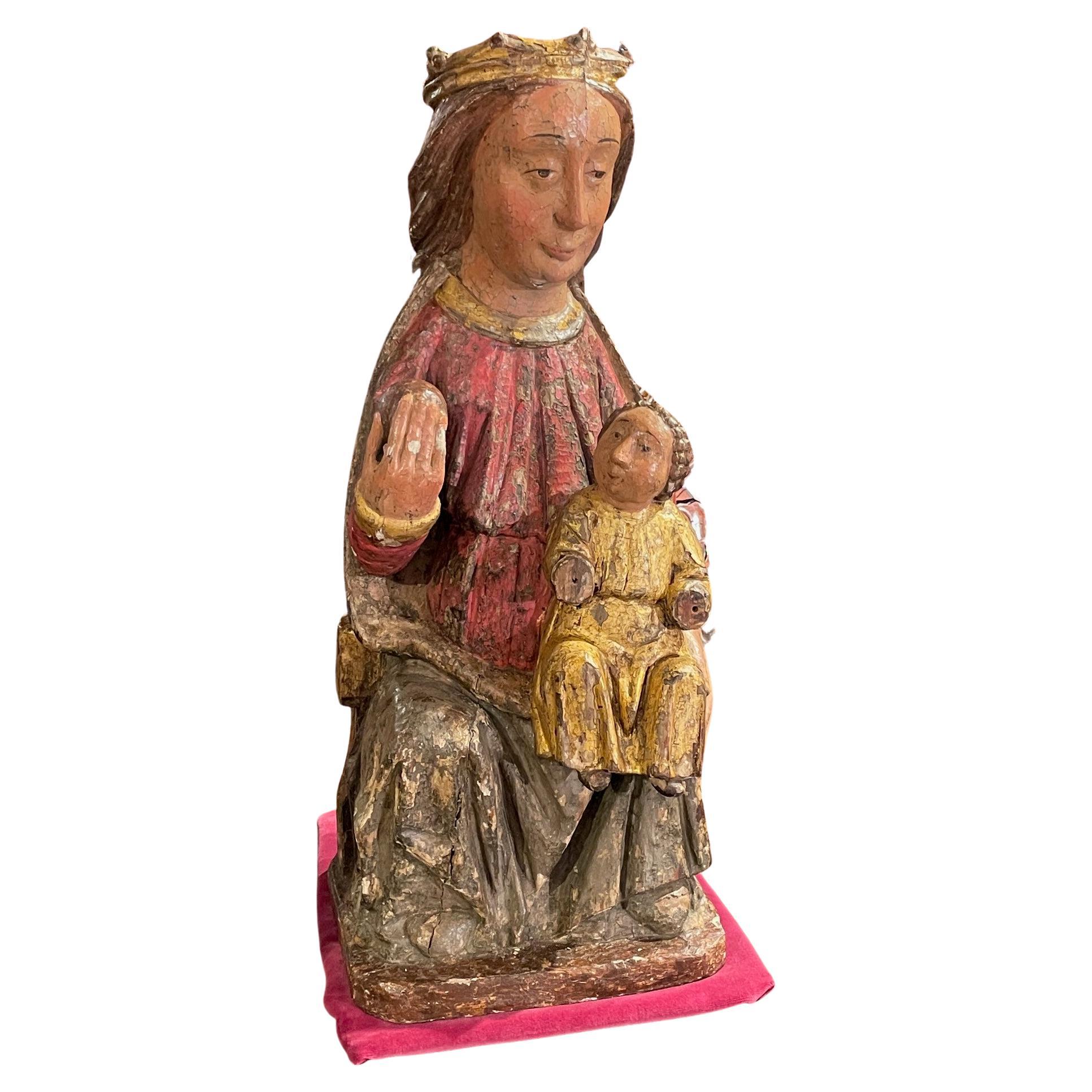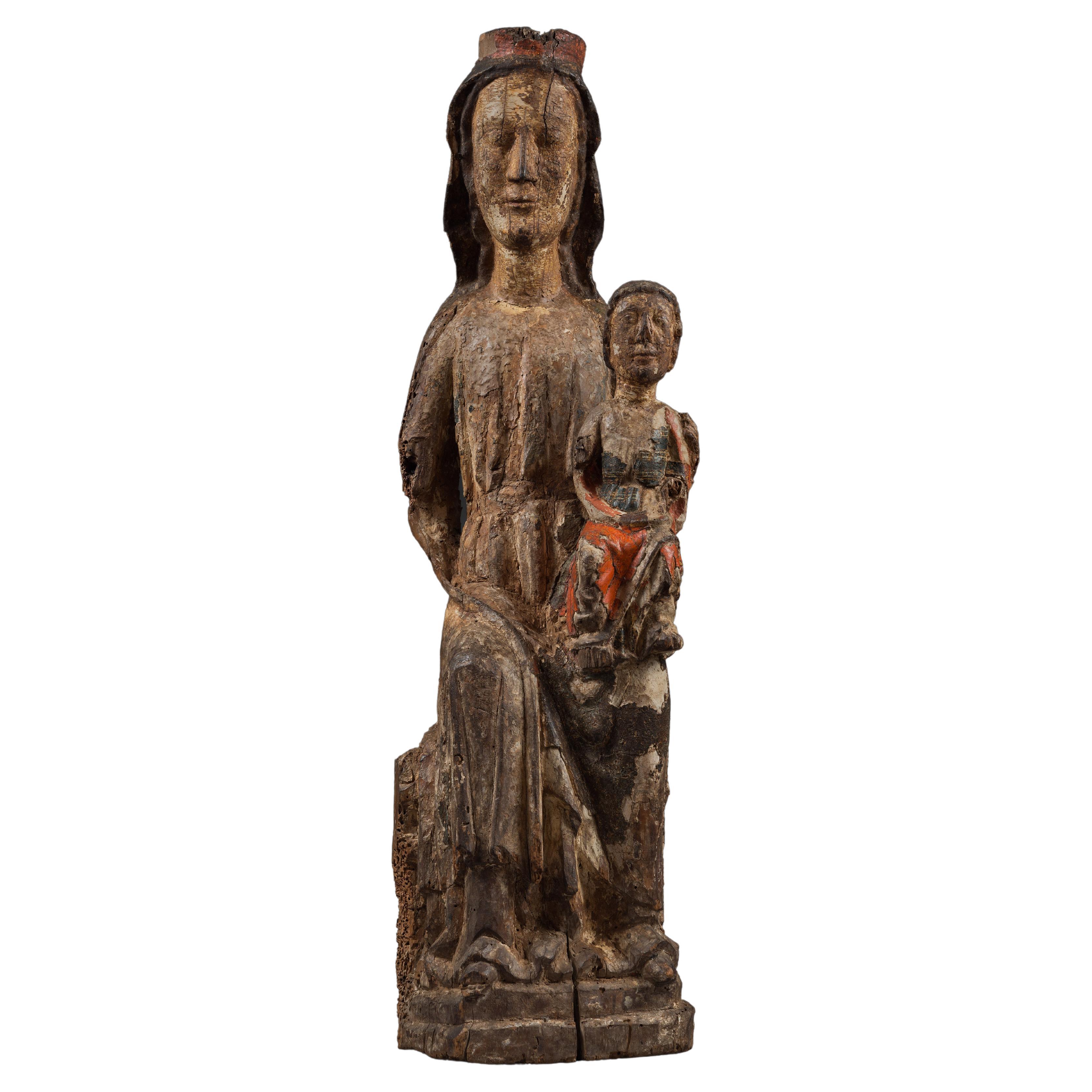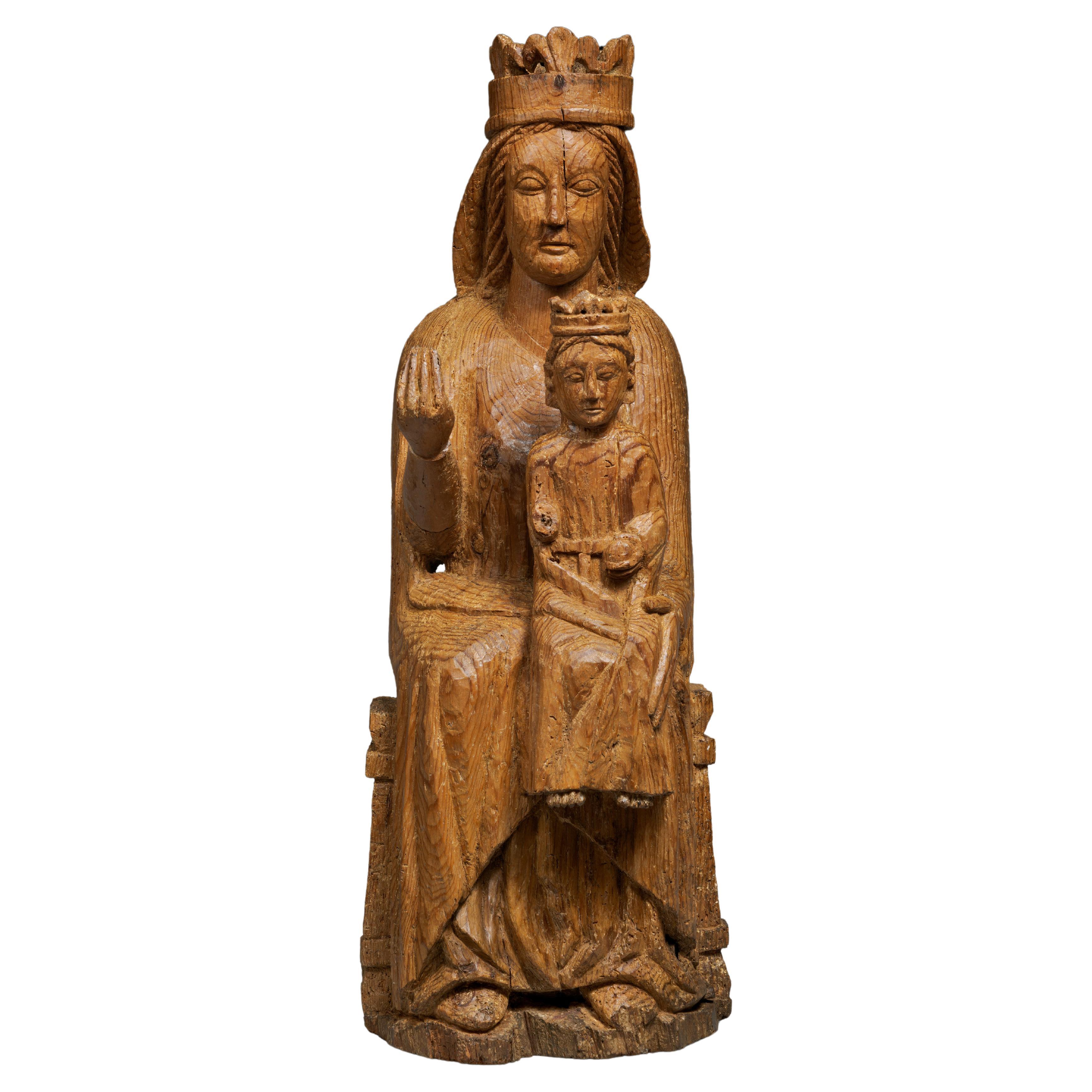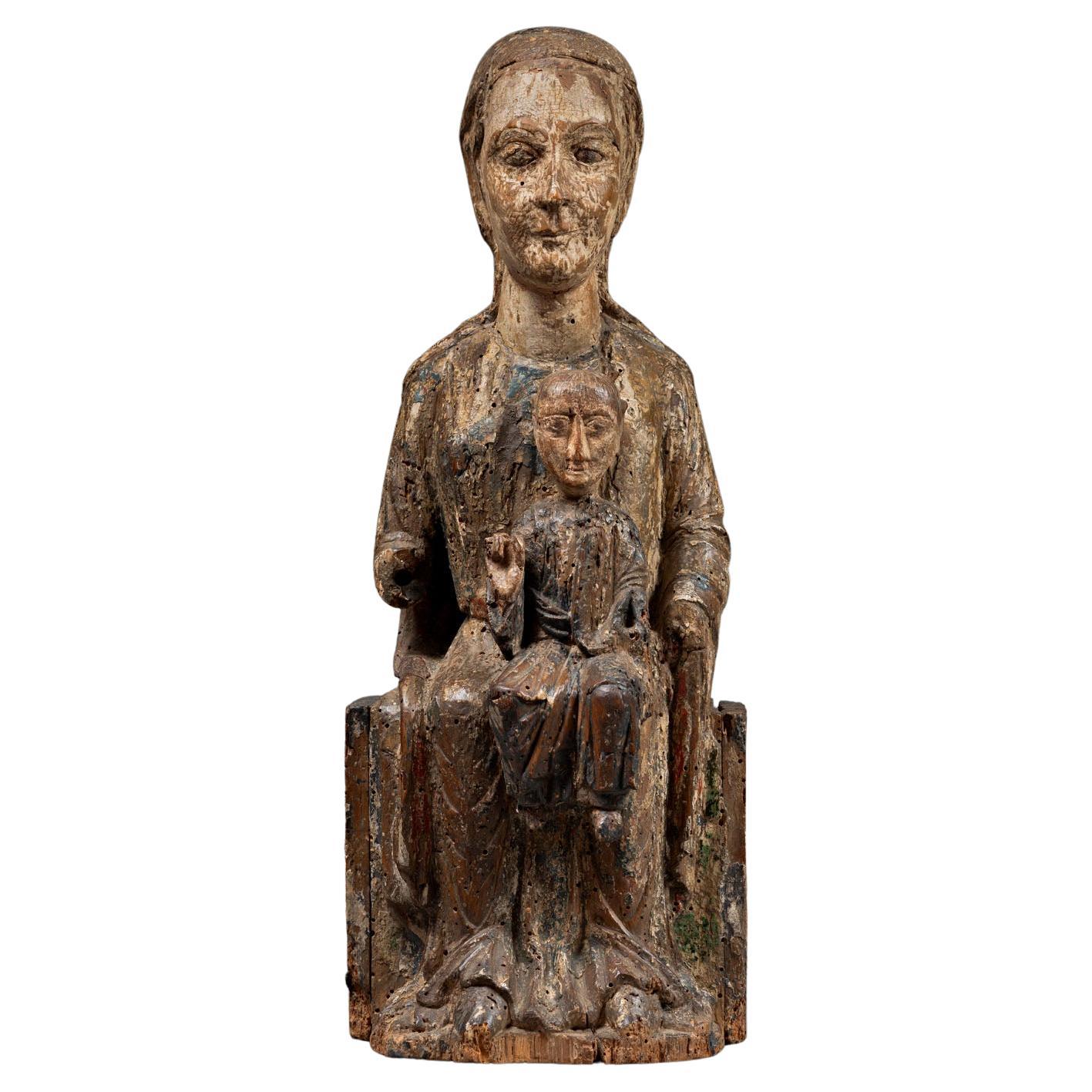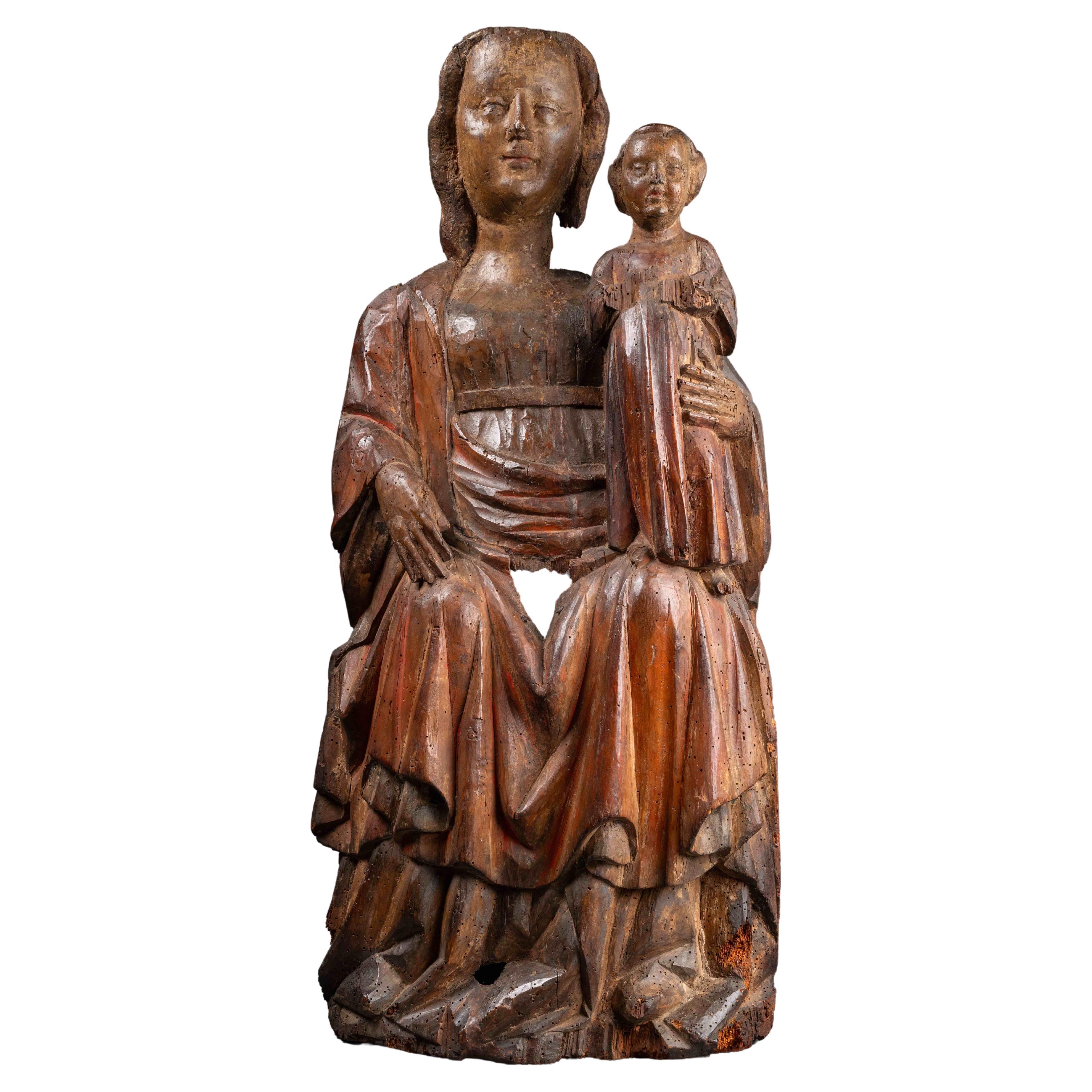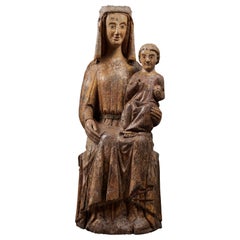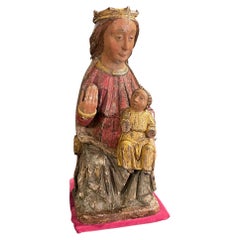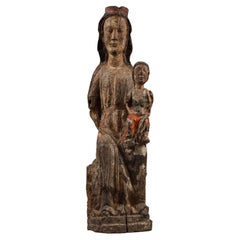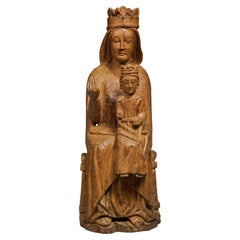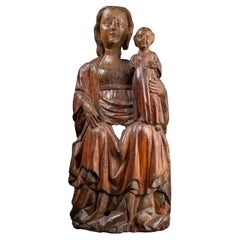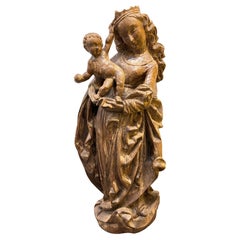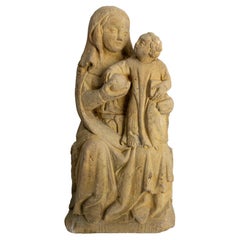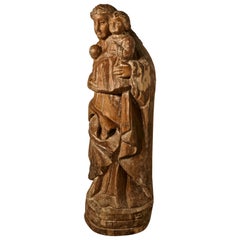Items Similar to Virgin and Child in Majesty with a Bird
Want more images or videos?
Request additional images or videos from the seller
1 of 8
Virgin and Child in Majesty with a Bird
$53,359.62
£40,101.94
€45,000
CA$74,727.48
A$81,953.07
CHF 42,445.92
MX$984,730.48
NOK 534,495.33
SEK 501,639.14
DKK 342,915.61
About the Item
Virgin and child in majesty with a bird
Origin: Southern Germany Or Austria
Period: Late 13tth - Early 14th Century
Height : 87.5 cm
Length : 32 cm
Depth : 19 cm
Lime wood
Mary is depicted on a throne bench of which we can only see the sides. She wears a tunic and a cloak covering her laps in the manner of an apron. The draperies are supple and follow the shape of the body.
Her face presents fine features with a high forehead, straight and thin nose and is framed by strands of curly hair.
She has delicate hands with elongated fingers. In her right hand she used to hold a flower of which only remains the stem. She holds the child Jesus on her left fore-arm. He wears a long tunic. His feet can be seen in the folds of the fabric. He holds a bird in his hands.
This group of the Virgin and Child still retains a straight and hieratic posture, the gaze unwavering. However, the child is slightly moving to the left side and shows a slight smile full of humanity. Those few characteristics, the fluid fabric, the large eyes and straight nose support a datation to the the late 13th century or the early years of the following century.
The presence of a bird as a symbolic element also stands in favour of such a datation. Indeed, it becomes a recurring attribute around the 13th century and can be interpreted in various manners.
The dove can represent the Holy Spirit. In 325, during the first Council of Nicea the Holy Spirit is recognised as the third hypostasis (entity) of the Trinity. In artistic depictions, the Holy Spirit is then symbolised as a dove. It reminds us of the divine conception of Jesus and his true nature.
However the dove appears very early in Paleochristian art where it stands for the freed soul saved by death.
Sometimes identified as a goldfinch, the bird is in that case a symbol of Jesus’ upcoming sacrifice.
It is then difficult to determine with certainty if the iconography of the bird is adopted by the sculptors as a way of evoking the true nature of Jesus or the divine sacrifice that will take place with the crucifixion.
- Dimensions:Height: 34.45 in (87.5 cm)Width: 12.6 in (32 cm)Depth: 7.49 in (19 cm)
- Materials and Techniques:
- Period:
- Date of Manufacture:Late 13th-Early 14th Century
- Condition:Minor structural damages.
- Seller Location:Saint-Ouen, FR
- Reference Number:1stDibs: LU3115329586752
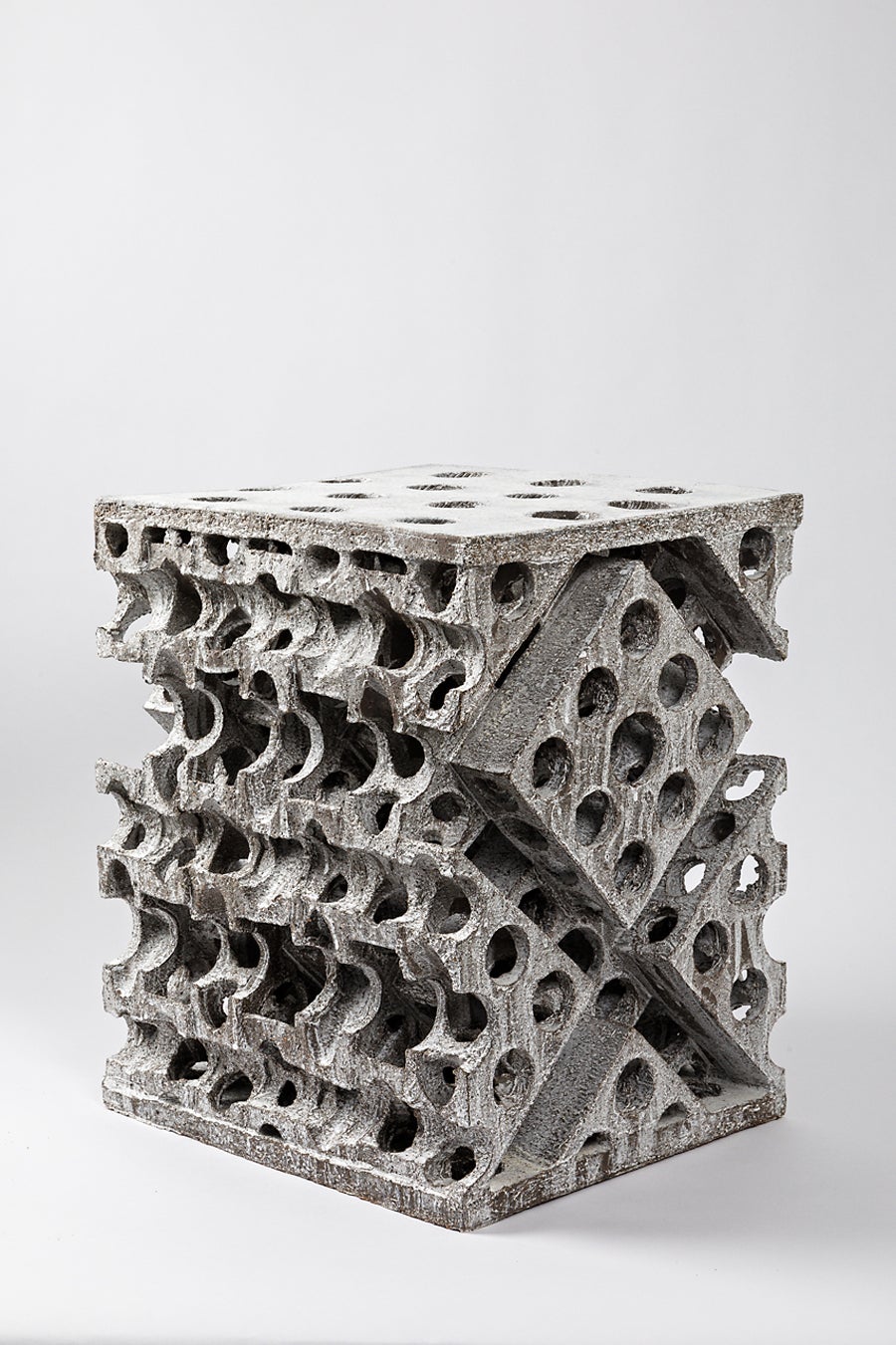
About the Seller
5.0
Vetted Professional Seller
Every seller passes strict standards for authenticity and reliability
Established in 2016
1stDibs seller since 2017
203 sales on 1stDibs
Typical response time: 2 hours
- ShippingRetrieving quote...Shipping from: Saint-Ouen, France
- Return Policy
Authenticity Guarantee
In the unlikely event there’s an issue with an item’s authenticity, contact us within 1 year for a full refund. DetailsMoney-Back Guarantee
If your item is not as described, is damaged in transit, or does not arrive, contact us within 7 days for a full refund. Details24-Hour Cancellation
You have a 24-hour grace period in which to reconsider your purchase, with no questions asked.Vetted Professional Sellers
Our world-class sellers must adhere to strict standards for service and quality, maintaining the integrity of our listings.Price-Match Guarantee
If you find that a seller listed the same item for a lower price elsewhere, we’ll match it.Trusted Global Delivery
Our best-in-class carrier network provides specialized shipping options worldwide, including custom delivery.More From This Seller
View AllImportant Virgin and Child in Majesty
Located in Saint-Ouen, FR
Important virgin and child in majesty
Origin : Germany Or Eastern France
Époque : Second Half Of The 13th Century
Height: 104.5 cm
Length: 3...
Category
Antique 15th Century and Earlier Figurative Sculptures
Materials
Oak
Virgin and Child in Majesty
Located in Saint-Ouen, FR
Virgin and child in majesty
Origine: castille
Epoque: early 14th century
Measures: Height: 72cm
Length: 30cm
Depth: 25cm
Polychrome and gi...
Category
Antique 15th Century and Earlier Figurative Sculptures
Materials
Wood
$41,501
Virgin and Child "Sedes Sapientiae", Seat of Holy Wisdom
Located in Saint-Ouen, FR
Virgin and child sedes sapientiae, seat of holy wisdom
Origin : Northern Spain, castile, navarre or galicia.
Period : early 13th century.
Heigh...
Category
Antique 15th Century and Earlier Figurative Sculptures
Materials
Wood
Virgin and Child in Majesty, also known as "Sedes Sapientae"
Located in Saint-Ouen, FR
VIRGIN AND CHILD IN MAJESTY, ALSO KNOWN AS "SEDES SAPIENTIAE"
ORIGIN : SPAIN, CATALOGNE
PERIOD: EARLY 13th CENTURY
Height : 95 cm
Width : 32 cm
Depth : 28 cm
Softwood
No polychromy
In the middle of the 12th century, the Virgin took her place in churches, seated in Majesty, serving as a throne for her son Jesus. She is then called Sedes Sapientiae, meaning the Throne of Wisdom.
At that time, she is not represented for herself and only exists because she has been designated as Theotokos, the mother of God, at the Council of Ephesus in 431, where the divine nature of Christ was proclaimed from his birth.
The upright and perfectly hieratic bust of this Virgin and Child in Majesty is seated on a throne-bench. She is dressed in a tunic with a rounded neckline and covered with a fine mantle placed on her narrow shoulders. The supple and natural drapery follows the lines of the body.
Large curls frame her face with delicate and regular features, a long straight nose, almond-shaped eyes, and small lips.
She supports the Infant Jesus with her left hand. Like his mother, he is dressed in a long tunic, and his little feet are visible in the folds. He holds a small sphere in his left hand, while with his right hand, he gestures in blessing. The face of Christ bears a strong resemblance to his mother’s one, and he gives a slight smile.
The position of the Child is no longer as hieratic, nor frontal or central as in the early 12th century, but his face still turns towards the faithful.
The 13th century indeed emerges as a period of transition in the artistic domain. The statuary, while retaining certain characteristics still belonging to the habits of the previous century, also develops new formal solutions.
As a result, Mary maintains a hieratic and frontal position, while her son shifts to place himself well to the left on her knee. Similarly, while the Virgin seems perfectly still, Jesus, on the other hand, appears much more animated, especially in the positioning of his hands. His left hand holds the orb, and judging by the raised right arm directed towards the faithful, one can easily imagine that he was making a gesture of blessing.
The influence of the Sedes Sapientiae from previous centuries still seems particularly prevalent in this work.
These few characteristics allow dating this Spanish Virgin...
Category
Antique 15th Century and Earlier Spanish Gothic Figurative Sculptures
Materials
Softwood
Exceptional Virgin and Child in Majesty or "Sedes Sapientiae", Throne of Wisdom
Located in Saint-Ouen, FR
Exceptional virgin and child in majesty
or “Sedes Sapientiae”, throne of wisdom
Origin: southwestern France.
Period: late 12th - early 13th cen...
Category
Antique 15th Century and Earlier Figurative Sculptures
Materials
Walnut
Gothic Virgin and Child from Flanders
Located in Saint-Ouen, FR
Exhibition
Museum Cantini, 1952, The art of the Middle Ages in the Marseille collections, n°101
Provenance
Former collection Louis Bresset (before 1952)
Former collection Profe...
Category
Antique 15th Century and Earlier Dutch Gothic Figurative Sculptures
Materials
Oak
You May Also Like
Virgin and the Child, Mosan Region, Second Half of 13th Century
Located in Bruxelles, BE
A polychrome sculpture depicting the Virgin and the Child
Mosan region, second half of 13th century
Polychrome wood
73 x 29 X 12 cm
Provenance :
Former Belgian private collection from the beginning of the 20th century
This remarkable early artwork portrays the Enthroned Virgin and Child, also known as Sedes Sapientiae, which translates to the 'Seat of Wisdom...
Category
Antique 15th Century and Earlier Belgian Medieval Figurative Sculptures
Materials
Wood
Antique Statue of Virgin Mary and Child , 19th Century
Located in Basildon, GB
A Pine Carving of Virgin and Child signed E. Lechner. Carved in 15th Century style, a high relief with a hollowed back and depicting the crowned Virgin standing on contrapose with lo...
Category
Antique Mid-19th Century European Gothic Religious Items
Materials
Wood, Pine
French Antique Statuette Virgin and Child Early 20 th Century
Located in Labrit, Landes
French handmade stone statue in stone Madonna and Child.
As you can see from the photos, the Mother and the Child exchange an expressive look full of tenderness.
The directing style ...
Category
Early 20th Century French Animal Sculptures
Materials
Stone
18th Century French Carved Statue of Madonna and Child
Located in Godshill, Isle of Wight
18th century French carved statue of Madonna and Child.
This charming piece has been rescued from a ecclesiastic clear out in the southern part of France
The statue is carved fro...
Category
Antique Mid-18th Century Mission Figurative Sculptures
Religious Statue of Our Lady and Child, 20th Century
Located in Lisbon, PT
This captivating 20th-century wood sculpture depicts Our Lady holding the Child Jesus, crafted from warm wood with a timeless elegance.
Standing at 84 cm tall, the statue exudes a s...
Category
20th Century Portuguese Baroque Figurative Sculptures
Materials
Wood
$2,916 Sale Price
20% Off
Wooden Madonna with Child Baroque Art Italy 17th Century with Export Certificate
Located in Madrid, ES
A Wooden Madonna with child Baroque art, Southern Italy, 17th century.
Measure: H: 71cm
Good condition for the time.
With Export Certificate to USA.
Category
Antique Early 17th Century Italian Baroque Figurative Sculptures
Materials
Wood
More Ways To Browse
Virgin And Child
Holy Spirit
The Goldfinch
Throne Bench
Antique Erotic Furniture
Banana Tree
Bronze Egyptian Sculpture
Carved Marble Head
Patinated Plaster Sculpture
Small Metal Sculptures
South Africa Art Sculpture
Art Deco Glass Figurine
Balinese Carved
Balinese Wood
Bisque Sculpture
Bronze Faun
Bronze Musician
Male Statue
